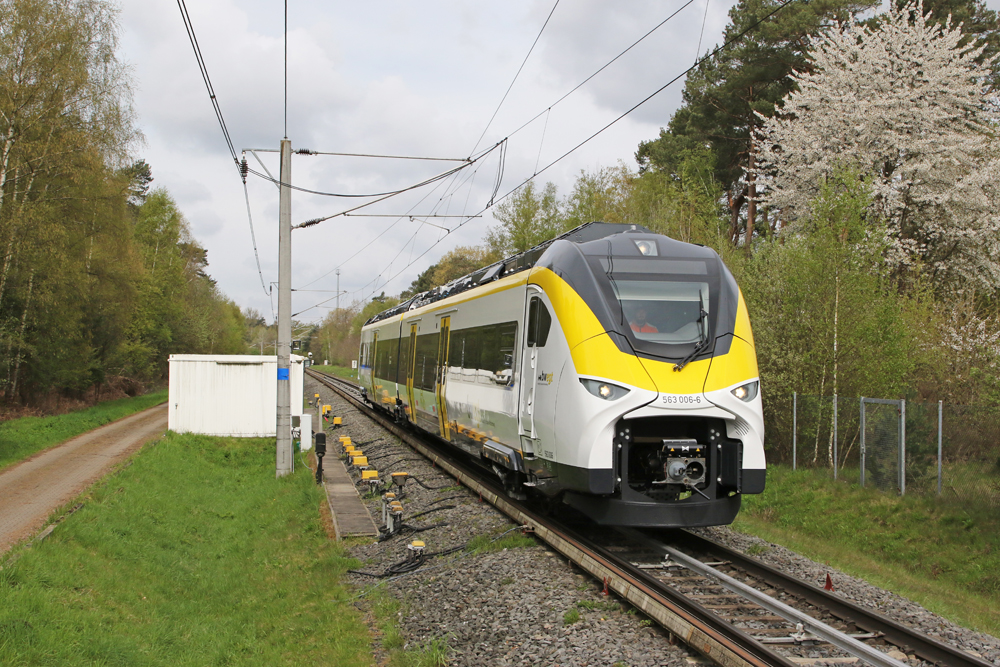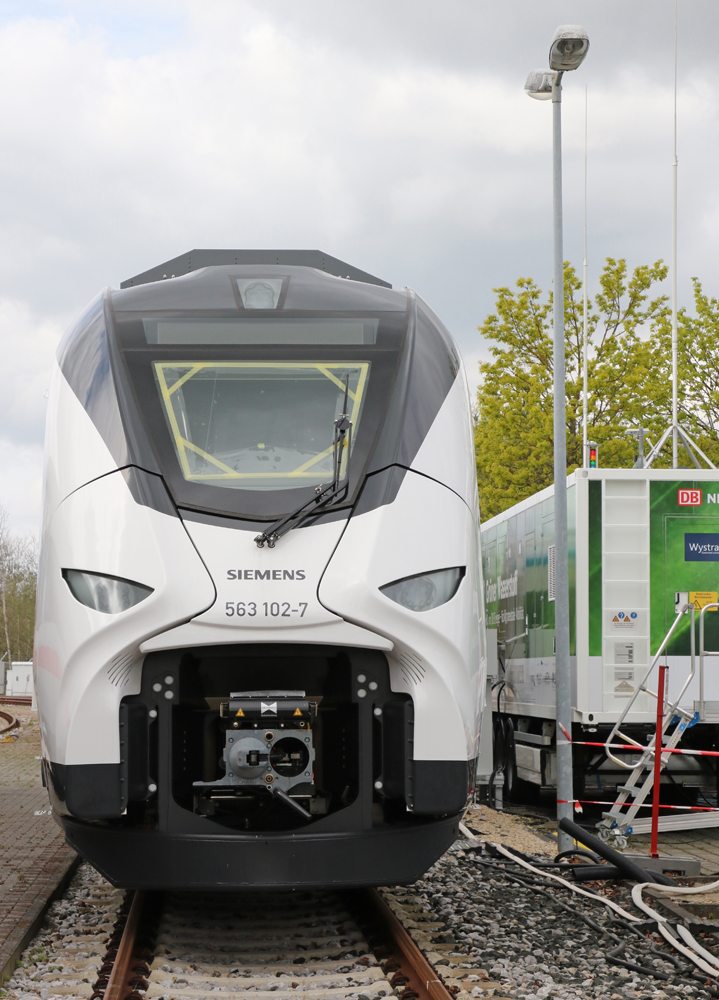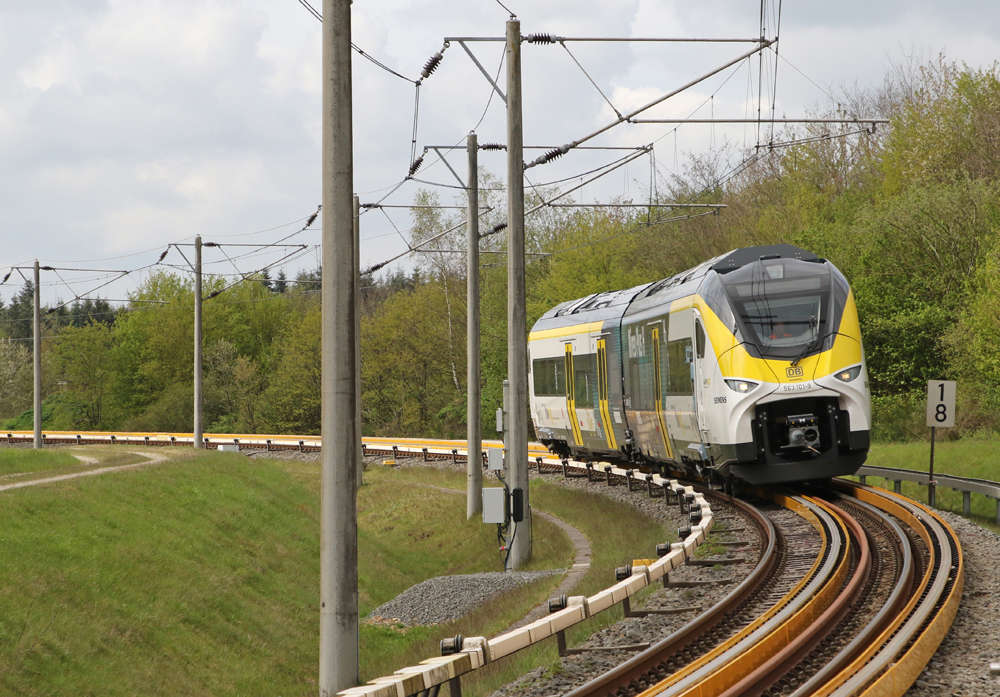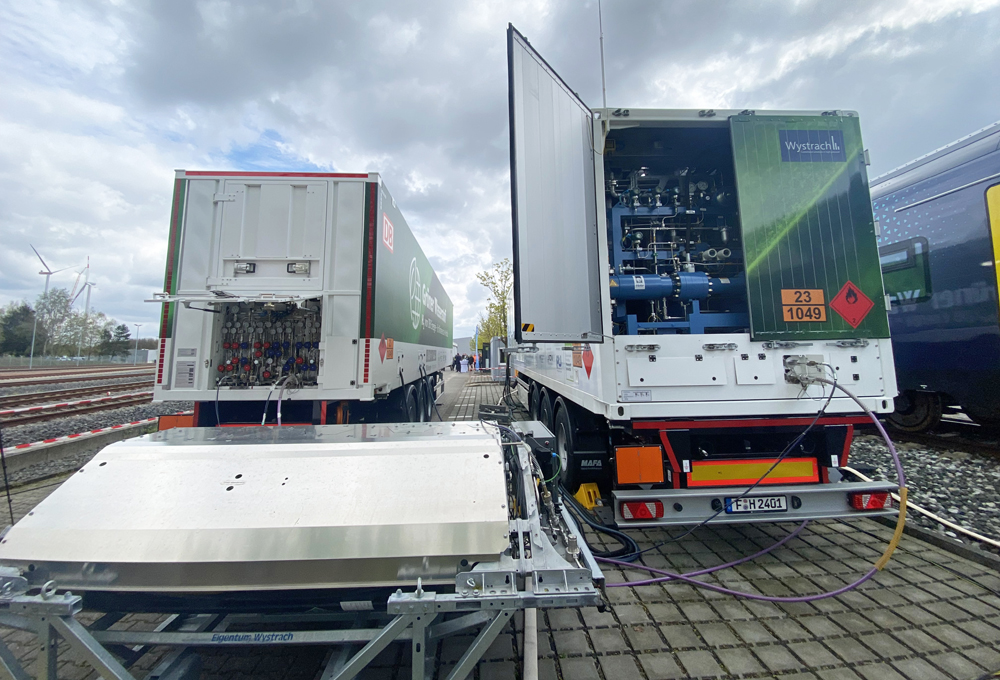
WILDENRATH, Germany — A recent presentation by Siemens offered the opportunity to compare the company’s new hydrogen and battery trains for Europe, and provided a look at a new road-transport-based mobile hydrogen filling station.
The equipment was presented at the Siemens-owned test center in northwestern Germany. The Wildenrath facility, with two test loops, is built on the site of a former British air force base that closed in the 1990s.
The hydrogen and battery trains are both based on the company’s Mireo commuter/regional rail electric multiple-unit trainset sold mainly in Germany. The alternative-fuel equipment was previously displayed at the InnoTrans trade fair in Berlin last September [see “Siemens optimistic about U.S. passenger market,” Trains News Wire, Sept. 24, 2022]. However, the opportunity to ride on both at the same event, and compare the way the trains work and perform, was new. No other manufacturer has offered such a comparative experience, although Stadler and Alstom, the other two major European train builders, now have examples of both types of train.
Electric trains, with added energy sources
Perhaps not surprisingly, as large lithium-titanium-oxide batteries carried under the passenger cars are at the heart of both trains’ traction systems, their acceleration and noise levels were much like any other modern commuter EMU. Riding the hydrogen train, Siemens project engineers pointed out a faint high-pitched sound from the roof when the fuel cells, supplied by Canadian firm Ballard, were recharging the batteries. Had this not been pointed out, most riders would not even have noticed it.
The battery/EMU train, on the other hand, was just like the straight EMU versions already widely in service. Siemens says it has ensured the battery and hydrogen versions of the Mireo perform just like the pure EMU version in terms of acceleration, braking, and maximum speed of 100 mph. The hydrogen train only emits water vapor as it operates; thanks to a clever design, waste heat generated by the fuel cell is reused to power the air conditioning.

Where the trains differ from regular EMUs is their flexibility to go away from electrified routes. The hydrogen-powered train will have a range of up to 625 miles before refuelling and the battery one around 75 miles before recharging. Siemens — as you might expect from a company that literally helped invent electrical engineering in the 19th century — is up front in saying the best way to power a train is from continuous electrification. But the company admits this only makes economic sense for some rail lines in many countries.
Siemens’ sales pitch, in common with other major builders, is that trains combining regular EMU operation with batteries make sense for relatively short journeys away from electrified lines, but that hydrogen fuel cells combined with batteries can provide EMU-like performance over longer distances away from electrification. Siemens has been developing both trains for the last 5-7 years and has seen fuel cell and battery technology improve in efficiency in that time.
Experience so far in Europe shows the battery EMU concept is being widely adopted; these trains cost more than regular EMUs but nowhere near as much as hydrogen trains. Hydrogen trains are in service in Germany [see “World’s first hydrogen trains enter regular passenger service,” News Wire, July 26, 2022, and “Hydrogen-powered trains struggle …,” News Wire, Feb. 14, 2023]. But this has only been thanks to more than $500 million of extra subsidy from the German government, keen to prove the technology and gain manufacturing experience ahead of other nations.
Siemens managers privately concede that the high purchase cost of hydrogen trains puts off some customers. But they make the argument that compared to diesel trains they would replace, hydrogen trains will be cheaper in the long run, as almost nothing needs replacing during the trains’ service life. DMUs typically need full overhauls for engines and transmission around every eight years in countries like Germany or the UK, with new or re-conditioned engines installed five or six times over the train’s life. The hydrogen-powered Mireo Plus H train will need new fuel cells after 30,000 service hours – but as the fuel cell is only used for a few minutes in most hours of train operation, this total could take up a decade or more to reach. The batteries, on the other hand, are used more in both battery and hydrogen trains. They are expected to need replacing at between 35,000 and 50,000 hours’ use. By way of comparison, the auto industry currently expects to replace batteries after just 8,000 hours.

Fast refueling with ‘green hydrogen’
In preparation for passenger trials of the Siemens hydrogen trains in southern Germany starting in 2024, German national rail company Deutsche Bahn (DB) has developed a mobile hydrogen fuel system. Mounted in truck trailers, it currently comprises a storage vehicle and another with control systems and onboard computers to refuel trains trackside. The highly automated fuelling system uses computers onboard the train and the fueling station truck to control the pressure at which the hydrogen is loaded onto the train. This begins at low pressure and rises to up to 500 Bar (approximately 7,250 pounds per square inch), with the aim of filling the train’s two high-pressure hydrogen cylinders (capacity 90 kilograms, or 198 pounds) in 16 minutes.
A third module is being built which will make the hydrogen from water using electrolysis; currently the hydrogen is bought from the chemical industry. The power to make the hydrogen, most likely at night, will be drawn from overhead catenary at electrified rail depots, with the 15,000-volt AC used for traction current in Germany taken down to 400 volts to power the electrolysis system.
DB already claims to source most of its overhead traction power from non-fossil-fuel sources. DB Energy, the subsidiary responsible for providing power and fuel on much of the German network, has decided to use this system as it already owns most of the rail power grid, and using its own system won’t impact the local power grid in cities where the hydrogen-making system is in use.
The first system should be tested in the city of Tübingen, near Stuttgart, later this year.















Gerald, if DB purchases renewable sources of electricity that doesn’t change the generation mix in Germany. The electrons flow according to physics, not wishes. Whatever the PR states, most energy is non-renewable. From Wikipedia:
“As of 2021, German primary energy consumption amounted to 12,193 Petajoule, with more than 75% coming from fossil sources, 6.2% from nuclear energy and 16.1% from renewables.”
Nuclear is now shut down, without Russian gas, coal use has increased considerably. Further, wind generation is confined to the north; there is no significant transmission south or west. Germany has plenty of PV, but it is not a sunny place.
The project is a boondoggle and not driven by sensible energy or climate policy. Producing green hydrogen is great, but has not scaled anywhere.
We have to look to Europe to find companies that “Can Do” rather than telling you what they “Can’t Do”! Americans are excellent in telling organizations, “What they Can’t Do”.
“Green hydrogen” is an example of hopeium. Right now Germany and virtually every other country in the world generate electricity or make hydrogen using fossil fuels. There is no way to scale hydrogen production in the foreseeable future.
Hydrogen fuel cell trains are a solution looking for a problem. Or more cynically a way for corporations the receive government money that would be better invested in stringing catenary where it doesn’t exist. And running DMUs is an infitestimal contribution to climate change.
Just yesterday Trains Newswire reported similar misguided policies in California. There is a good case for electric switchers in the LA basin and catenary on mainlines. But sensible solutions are out of reach.
Right, because the same country that has already had several days of 100% non-fossil fuel power generation can’t figure out how to use electrolysis to convert plain old water into hydrogen and oxygen(which by the way, if they release it into the air as they should would actually be beneficial too). Did you read the article? Other than the mobile system being in diesel OTR vehicles it’ll be powered from the overhead AC system that the trains run on, which is almost exclusively powered by green energy on most days.